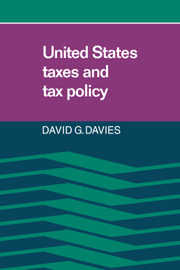Book contents
- Frontmatter
- Contents
- Preface
- 1 Economic foundations of U.S. tax policy
- 2 The individual income tax
- 3 Economic effects of individual income taxes and inflation
- 4 Expenditure versus income taxation
- 5 The taxation of capital gains
- 6 The corporation income tax
- 7 The corporation income tax and inflation
- 8 Social security payroll taxes
- 9 The value added tax
- 10 The sales tax
- 11 State taxes
- 12 Local government taxes
- 13 The distribution of tax burdens
- 14 Status of U.S. taxes and policy
- Appendix
- References
- Index
- Frontmatter
- Contents
- Preface
- 1 Economic foundations of U.S. tax policy
- 2 The individual income tax
- 3 Economic effects of individual income taxes and inflation
- 4 Expenditure versus income taxation
- 5 The taxation of capital gains
- 6 The corporation income tax
- 7 The corporation income tax and inflation
- 8 Social security payroll taxes
- 9 The value added tax
- 10 The sales tax
- 11 State taxes
- 12 Local government taxes
- 13 The distribution of tax burdens
- 14 Status of U.S. taxes and policy
- Appendix
- References
- Index
Summary
Introduction
The value added tax (VAT), a relatively new type of tax, is a major form of taxation in Europe. In addition to the European Economic Community (EEC), which now requires its members to have such a levy, Finland, Norway, and Sweden all have value added taxes. Most of the Latin American countries also use a VAT.
The rapid ascendancy of the VAT in so many countries has contributed to a growing interest in its possible use in the United States, and a lively debate has emerged between proponents and opponents. Advocates first proposed it as a replacement for all or part of the tax on corporation income. President Nixon proposed the VAT as a way of reducing property taxes used to finance local schools (Strout 1978:5). Richard W. Lindholm, an economist and perhaps the leading proponent of the VAT, suggested that its chief advantage would be to boost exports and thereby help solve balance of payments problems (Halverson 1979c: 11). It has also been considered as a principle source for additional income to finance rapidly expanding government expenditures and more recently as a means of alleviating the rising burden of social security and income taxes (Long 1978:7), as well as the national debt.
- Type
- Chapter
- Information
- United States Taxes and Tax Policy , pp. 200 - 216Publisher: Cambridge University PressPrint publication year: 1986



